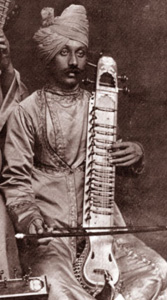
THE SOUND OF THE HEART
The Dilruba is derived from the Taus and some argue that it is the work of the 10th Sikh Guru, Guru Gobind Singh, while the Taus was the work of Guru Hargobind (the sixth Guru of the Sikhs). The Dilruba was then produced to replace the Taus, this instrument being too heavy to carry. This rethinking led to the reduction of the Taus into what is now known as the Dilruba.
The structure of the two instruments esraj and dilruba is very similar, each is a smaller sitar with a 20 fret neck. Its neck stands on a long wooden stand of 12-15 sympathetic strings. While the dilruba has more sympathetic strings and a different body shape than the esraj, they both have four main strings that sit on a curved bridge. All strings are made of metal. The soundboard is a stretched piece of goat skin similar to what is found on the sarangi. Sometimes the instrument has a gourd as a resonator affixed just above it, both for balance or for perfecting the tone of the harmonics.
The instrument can be placed between the knees while the player is on the floor, or usually placed on the player’s knee, or also on the floor just in front of the player, with the neck placed on the left shoulder. It is played with a bow, palm up, the other hand moving along the strings over the frets, without pressing. The player can slide the note up or down, making portamento, or meend, characteristic of Indian music.
The esraj is mostly used as an accompaniment instrument. It is the instrument chosen by Rabindra Sangeet to accompany his singing. However, it has also been used as a solo instrument to perform Hindustani Classical Music, mostly in the Vishnupur tradition. It may be noted that the esraj is a more modern invention than the Dilruba which was made and promoted by the Namdharis.
The popularity of the esraj and dilruba had solidly declined. Its image as an accompanying instrument did little to attract new talent. The soloist Mad Sheer Khan has championed the esraj and dilruba for thirty years on stages around the world, even immersing it in Western urban cultures, giving this noble instrument the opportunity to express the qualities of a universal sound in the service of a 360° culture.
Notable players
Ravi Shankar (then known as Rabindra) played the esraj and dilruba in the 1930s as a member of his older brother Uday Shankar’s dance band. On the Beattles’ album “Sergeant Peppers”, he plays it in “Within you, Without you” by Georges Harisson, which Mad Sheer Khan covers in his album “Far Oued”.
Probably the most famous instrumentalist of the esraj was Pandit Raie of Ranadhir, who died in 1988. Ranadhir Raie was a student of Ashesh Bandopadhyay, and was on the faculty of the music department of Visva-Bharati University in Santiniketan. Today, the best known Indian soloist is Buddhadeb Das, also from Santiniketan.
R Rahman is known as one of the composers in India who used the Dilruba, in works like “Vande Mataram”.
